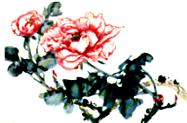A twig of flower includes flower, leaf and stem. To paint a flower, observe the form of the flower first, then the position, the color and the relation of one flower to the other.
The flower does not stand alone, and in most cases it is accompanied by leaves or other twigs.
The leaves dangle in the air, and even a gentle
breeze may stir a thick foliage. So leaves often add movement to
a flower-piece and enliven the whole picture.
The herbs and the shrubs
There are herbs and shrubs, the herbs are having
weaker stems while the shrubs looking stronger and straighter.
To compose a flower-piece first arrange the main branches and then add the minor twigs.
Usually there are three methods of arranging the
branches, i.e.
Pointing up, pointing down, and pointing sidewise
To paint a flower piece, generally do the flowers
and leaves first, and then the stem.
Add the veins of the leaves and dot the flower-buds
later on.
To paint a shurb, however, you may do the stems and branches first and then flowers and leaves.
When painting the flowers, watch for the arrangement
to vividly capture the delicate oscillation of the petals.
 Elaborate
Style
Elaborate
Style Spontaneous Style
Spontaneous StyleUse both of the contour technique and the non-outlining technique in the " combination style ". Some painters who prefer " Elaborate Style " may only use lines to suggest form and texture, and others paint in the " Spontaneous Style " who apply bold brushstrokes freely to express rhythmc beauty.

